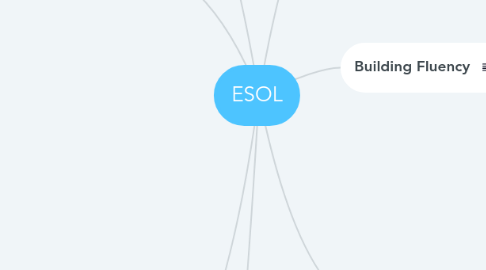ESOL
por Carol Wagner


1. Assessment Strategies
1.1. Informal
1.1.1. Portfolios
1.1.2. Informal Assessment Checklist
1.2. Formal
1.3. Students at risk and teacher tips article
2. Alphabetic Principle
2.1. Phonemic and phonological awareness
2.2. Using games, rhymes, stories, and songs
2.3. Readiness article
2.4. Encourage reading at home in both L1 and L2
2.5. Karen Tankersley: “Teaching children to manipulate sounds in language helps all types of readers learn to read.”
3. Comprehension
3.1. Definition: Making meaning out of text
3.2. Teaching vocabulary
3.2.1. Be intentional
3.2.2. Teach in context and not dictionary definitions
3.2.3. Make connections based on prior knowledge and experiences
3.3. Give students a toolbox of strategies to help comprehension
3.4. Fluency - cannot make meaning out of text if a reader has to decode and define a lot of the text
3.5. Productive and Passive language - need both, but there should be a balance
3.6. Good reading habits at home for both fiction and non fiction
3.7. Cognates - use, but beware of false cognates
3.8. Skills that transfer between L1 and L2 include:
3.8.1. Making meaning from print
3.8.2. Cause and effect
3.8.3. Purposes for reading
3.8.4. Comprehension strategies
3.8.5. Text Structure
3.8.6. Making predictions
3.8.7. Understanding that reading can be fun, informational, and a way to learn
4. L2 Learners with Special Needs
5. Cultural Differences
5.1. Individualism vs. Collectivism
5.2. ALWAYS be sensitive to students and parents!
5.3. Appropriate Content for age, level, and culture
5.4. Communicating cross culturally - problem solving strategies can vary.
5.5. Webmentor's Helpline - great tools!
5.6. Writing is culturally specific
6. Building Fluency
6.1. Reading rate and using timed readings
6.2. Comprehension - students must be able to comprehend as they read, and not have to stop frequently to decode and define words
6.3. Expressiveness - students must read with appropriate tone of voice, expression, and use the clues provided by punctuation marks.
7. Significant Learning
7.1. Six Traits
7.1.1. Learning how to learn
7.1.2. Foundational knowledge
7.1.3. Application learning
7.1.4. Integration
7.1.5. The Human dimension of learning
7.1.6. Caring

